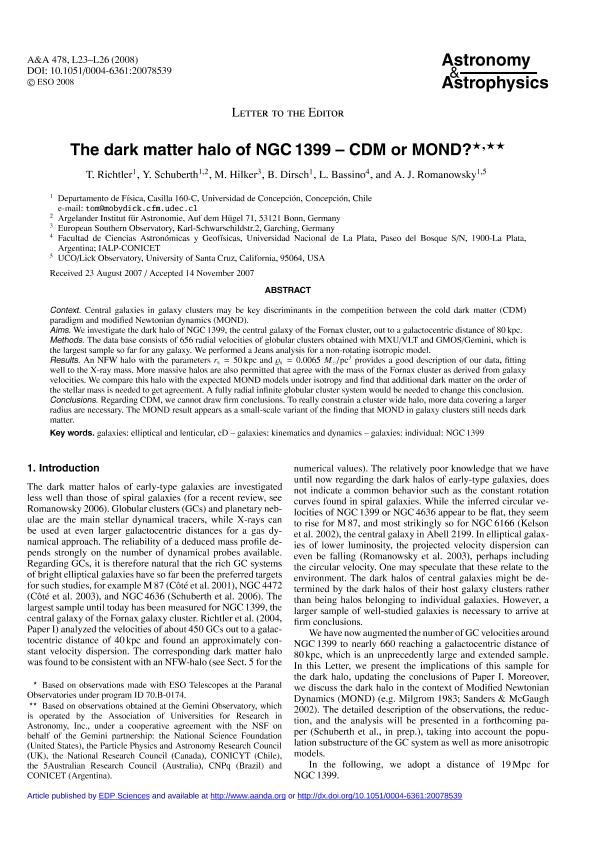Mostrar el registro sencillo del ítem
dc.contributor.author
Richtler, T.
dc.contributor.author
Schuberth, Y.
dc.contributor.author
Hilker, M.
dc.contributor.author
Dirsch, B.
dc.contributor.author
Bassino, Lilia Patricia

dc.contributor.author
Romanowsky, A. J.
dc.date.available
2018-05-04T12:34:01Z
dc.date.issued
2008-02
dc.identifier.citation
Richtler, T.; Schuberth, Y.; Hilker, M.; Dirsch, B.; Bassino, Lilia Patricia; et al.; The dark matter halo of NGC 1399: CDM or MOND?; EDP Sciences; Astronomy and Astrophysics; 478; 2; 2-2008; L23-L26
dc.identifier.issn
0004-6361
dc.identifier.uri
http://hdl.handle.net/11336/44106
dc.description.abstract
Context. Central galaxies in galaxy clusters may be key discriminants in the competition between the cold dark matter (CDM) paradigm and modified Newtonian dynamics (MOND). Aims. We investigate the dark halo of NGC 1399, the central galaxy of the Fornax cluster, out to a galactocentric distance of 80 kpc. Methods. The data base consists of 656 radial velocities of globular clusters obtained with MXU/VLT and GMOS/Gemini, which is the largest sample so far for any galaxy. We performed a Jeans analysis for a non-rotating isotropic model. Results. An NFW halo with the parameters rs = 50 kpc and s = 0.0065 M/pc3 provides a good description of our data, fitting well to the X-ray mass. More massive halos are also permitted that agree with the mass of the Fornax cluster as derived from galaxy velocities. We compare this halo with the expected MOND models under isotropy and find that additional dark matter on the order of the stellar mass is needed to get agreement. A fully radial infinite globular cluster system would be needed to change this conclusion. Conclusions. Regarding CDM, we cannot draw firm conclusions. To really constrain a cluster wide halo, more data covering a larger radius are necessary. The MOND result appears as a small-scale variant of the finding that MOND in galaxy clusters still needs dark matter.
dc.format
application/pdf
dc.language.iso
eng
dc.publisher
EDP Sciences

dc.rights
info:eu-repo/semantics/openAccess
dc.rights.uri
https://creativecommons.org/licenses/by-nc-sa/2.5/ar/
dc.subject
Elliptical Galaxies
dc.subject
Kinematics
dc.subject
Kinematics
dc.subject
Ngc 1399 (Galaxia)
dc.subject.classification
Astronomía

dc.subject.classification
Ciencias Físicas

dc.subject.classification
CIENCIAS NATURALES Y EXACTAS

dc.title
The dark matter halo of NGC 1399: CDM or MOND?
dc.type
info:eu-repo/semantics/article
dc.type
info:ar-repo/semantics/artículo
dc.type
info:eu-repo/semantics/publishedVersion
dc.date.updated
2018-04-23T15:34:52Z
dc.journal.volume
478
dc.journal.number
2
dc.journal.pagination
L23-L26
dc.journal.pais
Francia

dc.journal.ciudad
Les Ulis
dc.description.fil
Fil: Richtler, T.. Universidad de Concepción; Chile
dc.description.fil
Fil: Schuberth, Y.. Universidad de Concepción; Chile
dc.description.fil
Fil: Hilker, M.. European Southern Observatory; Alemania
dc.description.fil
Fil: Dirsch, B.. Universidad de Concepción; Chile
dc.description.fil
Fil: Bassino, Lilia Patricia. Universidad Nacional de La Plata. Facultad de Ciencias Astronómicas y Geofísicas; Argentina. Consejo Nacional de Investigaciones Científicas y Técnicas. Centro Científico Tecnológico Conicet - La Plata. Instituto de Astrofísica La Plata. Universidad Nacional de La Plata. Facultad de Ciencias Astronómicas y Geofísicas. Instituto de Astrofísica La Plata; Argentina
dc.description.fil
Fil: Romanowsky, A. J.. Universidad de Concepción; Chile
dc.journal.title
Astronomy and Astrophysics

dc.relation.alternativeid
info:eu-repo/semantics/altIdentifier/doi/http://dx.doi.org/10.1051/0004-6361:20078539
dc.relation.alternativeid
info:eu-repo/semantics/altIdentifier/url/https://www.aanda.org/articles/aa/abs/2008/05/aa8539-07/aa8539-07.html
Archivos asociados
